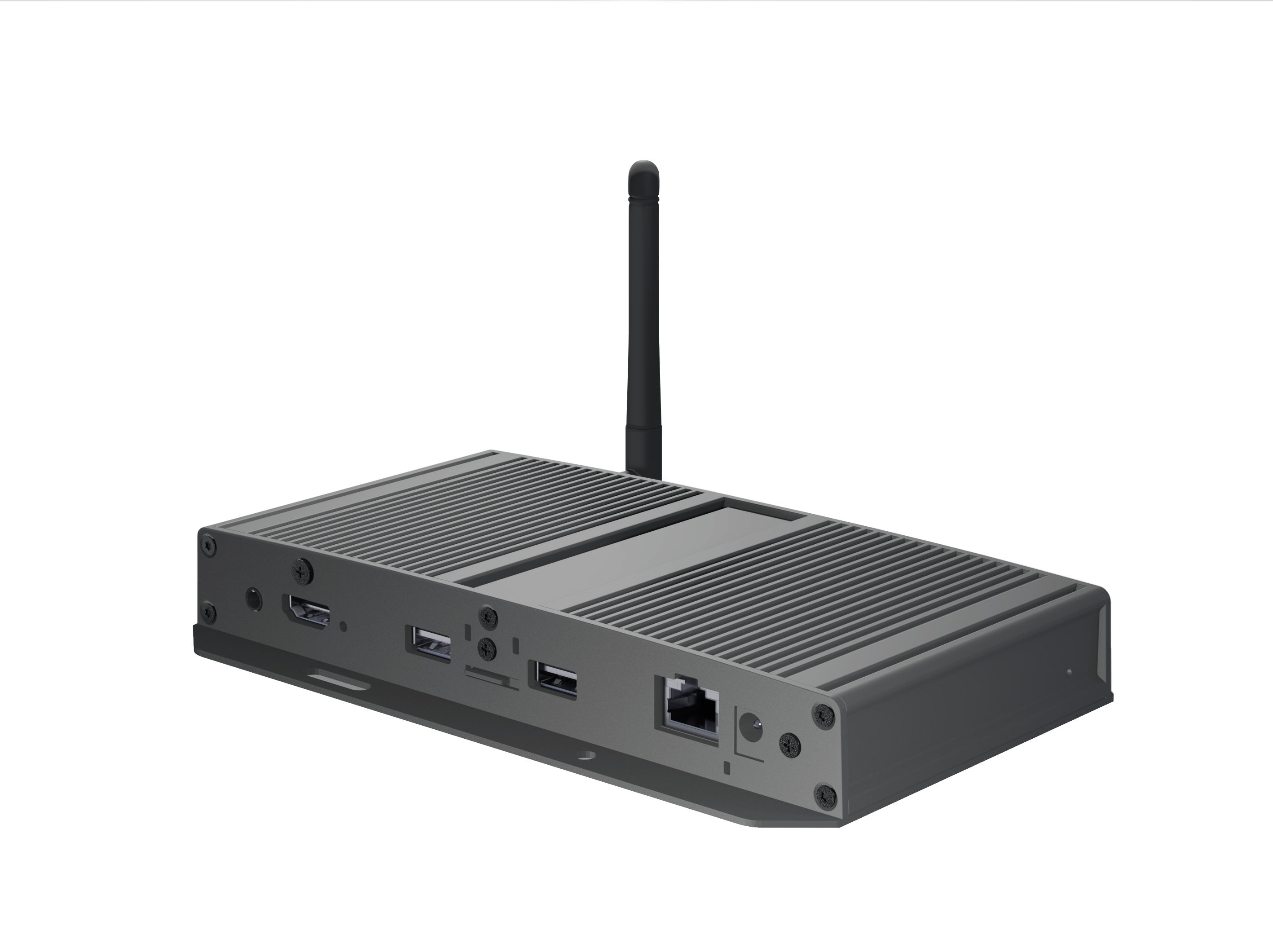Get your XMP-8552 media player up and running smoothly with our comprehensive installation guide.

Requirements
- One or more screens with an HDMI input to which the media player can be connected. If you want to control multiple screens with one media player (to play one program synchronously), you will also need video distribution equipment (HDMI splitters, cables, and possibly extenders).
- A power outlet with 24-hour power (for overnight updates) within 1 meter of the screen or the mounting location of the media player.*
- A network connection with internet access within 1 meter of the installation location of the media player. A wired network connection is the least likely to cause disruptions and is preferred over a Wi-Fi connection.
- Sufficient space behind the screen to place the media player. Dimensions: 110x70x30 mm (length x width x depth)
- Optional: a USB keyboard and mouse at the time of installation. This is necessary if you want to make adjustments to the basic settings of the media player, such as network settings, Wi-Fi, or video resolution.
Contents of the Installation Package
- Media player
- Power adapter 12V
- Network cable (2 m)
- HDMI cables 2 meters
- Wireless antenna
- 2 strips of double-sided adhesive Velcro
- Wall mounting plate with mounting bolts for media player
Before using the screen in portrait orientation (vertical), it is important to consult the installation manual of the screen. Not all brands are suitable for hanging in portrait mode. If the supplier allows portrait mode, you will need to rotate the screen to which the media player is connected by 90 degrees. In most cases, this rotation is done clockwise, but there may be exceptions. To ensure proper installation, it is recommended to refer to the supplier's installation manual or test the orientation with a connected media player beforehand.
Placement of the Media Player
Determine where you want to install the media player. You have the following options:
- Directly behind the screen using the supplied double-sided Velcro strips.
- Attach it to the wall near the screen using the supplied wall mounting plate. The supplied HDMI cables are 35 and 100 cm long and can both be used if necessary. Screws, wall plugs, or a longer HDMI cable can be purchased locally. Using HDMI cables longer than 10 meters is not recommended.
- Insert the media player directly into the HDMI input of the screen. In this case, secure the network and power cables in a way that prevents damage to the HDMI input when the cables are pulled.
If the player is placed more than 100 cm away from the HDMI input of the screen, a longer HDMI cable must be ordered or purchased separately. Keep in mind that this should be a "male-female" type of cable, i.e., an HDMI extension cable. A standard HDMI cable will not fit into the player.
If the distance between the power outlet and the installation location of the media player is more than 1 meter, a longer adapter must be ordered or purchased separately.
Installation of the Media Player
- Place the media player at the back of the screen or mount it on the wall.
- Connect the network cable to the internet connection and to the network port (LAN) of the media player.
- Connect the HDMI cable to the HDMI output of the media player and to a free HDMI input on the screen.
- Connect a network cable to the player (for Wi-Fi, see Network and Wi-Fi Settings).
- Turn on the screen and select the HDMI input to which your media player is connected according to the screen's manual. This is usually done with the remote control by pressing the "input" or "source" button.
- Connect the power adapter to the power outlet and to the media player (DC 12V). After about 30 seconds, a brief startup menu will appear:
After the startup menu, the content program will start.
If the player does not connect via the wired network settings, first check the cabling and then consult the network administrator.
Network and Wi-Fi Settings
The XMP-8552 is supplied as standard for a wired connection with automatic IP assignment (DHCP). If the player is connected to a Wi-Fi network or if the wired network requires a fixed IP configuration, this can be set in the media player's configuration menu.
Requirements
- A USB mouse
- A USB keyboard (optional)
Accessing the Configuration Menu
- Make sure the monitor is connected and visible from the media player.
- Connect the mouse and, if necessary, the keyboard to the USB ports of the media player.
- Start the media player by connecting the power adapter. After about 30 seconds, you will be given the option to access the media player's configuration menu.
- Select and click "cancel autoplay" with the mouse. Then click "advanced" to change the settings:
- Click on the pause icon.
- Network and other media player settings can be adjusted in the configuration menu.
Note: If the player is already running, you can also enter the configuration menu by placing the cursor in a corner of the screen and holding down the left mouse button for 15 seconds.
Setting up Wi-Fi
For a stable installation, it is recommended to connect the media player via a wired network. A wired connection provides the least chance of disruptions or update issues. If a wired network is not available and there is a Wi-Fi network with sufficient signal strength, the player can be connected to it:
- Click "advanced."
- Go to Network > Wireless LAN. First, turn off "Ethernet" by unchecking the box.
- The available Wi-Fi networks will be displayed. Select the network you want to connect to.
- If you have entered the password correctly, "connected" will appear after a while.
- You can now exit the menu with the back arrow at the bottom. Click twice, first to change the arrow from vertical to horizontal position and the second time to exit the page.
The player will return to the original screen of the configuration menu. If you do nothing, it will start playing again after 15 seconds.
Changes to Network Settings: IP Configuration
If the on-site wired network requires it, a fixed IP configuration can be set in the media player. First, consult the network administrator. The player is set to automatic configuration (DHCP) by default, which is sufficient in most cases. You can enter fixed IP settings as follows:
- In the advanced menu, click on "network."
- Open Ethernet > Static IP Settings, select > Change Network > Advanced Options > IP Settings" and click "static."
- Enter the data provided by the network administrator.
Click on "proxy" and select "manual." Enter the data provided by the network administrator.
You can now exit the menu with the back arrow at the bottom.
If the player does not connect to the wired network settings, first check the cabling and then consult the network administrator.
Network Issues:
If the player does not come online in your digital signage account, there may be an issue with the network. In this case, check if you can connect to the internet with another device (e.g., a laptop). If not, contact the network administrator. If a laptop can connect to the internet but the media player does not come online, you can contact the supplier.
Screen Issues:
If the screen does not display the content fully or is distorted, check the screen's manual to ensure the aspect ratio is set to 16:9 or full screen. If the screen does not accept a full HD signal, the media player can be set to a lower resolution. Contact the service center for assistance with this.
